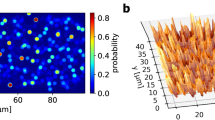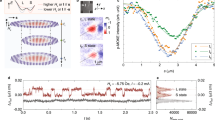Abstract
Magnetic skyrmions in thin films can be efficiently displaced with high speed by using spin-transfer torques1,2 and spin–orbit torques3,4,5 at low current densities. Although this favourable combination of properties has raised expectations for using skyrmions in devices6,7, only a few publications have studied the thermal effects on the skyrmion dynamics8,9,10. However, thermally induced skyrmion dynamics can be used for applications11 such as unconventional computing approaches12, as they have been predicted to be useful for probabilistic computing devices13. In our work, we uncover thermal diffusive skyrmion dynamics by a combined experimental and numerical study. We probed the dynamics of magnetic skyrmions in a specially tailored low-pinning multilayer material. The observed thermally excited skyrmion motion dominates the dynamics. Analysing the diffusion as a function of temperature, we found an exponential dependence, which we confirmed by means of numerical simulations. The diffusion of skyrmions was further used in a signal reshuffling device as part of a skyrmion-based probabilistic computing architecture. Owing to its inherent two-dimensional texture, the observation of a diffusive motion of skyrmions in thin-film systems may also yield insights in soft-matter-like characteristics (for example, studies of fluctuation theorems, thermally induced roughening and so on), which thus makes it highly desirable to realize and study thermal effects in experimentally accessible skyrmion systems.
This is a preview of subscription content, access via your institution
Access options
Access Nature and 54 other Nature Portfolio journals
Get Nature+, our best-value online-access subscription
$29.99 / 30 days
cancel any time
Subscribe to this journal
Receive 12 print issues and online access
$259.00 per year
only $21.58 per issue
Buy this article
- Purchase on Springer Link
- Instant access to full article PDF
Prices may be subject to local taxes which are calculated during checkout



Similar content being viewed by others
Data availability
The data that support the plots within this paper and other findings of this study are available from the corresponding author upon reasonable request.
References
Jonietz, F. et al. Spin transfer torques in MnSi at ultralow current densities. Science 330, 1648–1651 (2010).
Yu, X. Z. et al. Skyrmion flow near room temperature in an ultralow current density. Nat. Commun. 3, 988 (2012).
Jiang, W. J. et al. Blowing magnetic skyrmion bubbles. Science 349, 283–286 (2015).
Woo, S. et al. Observation of room-temperature magnetic skyrmions and their current-driven dynamics in ultrathin metallic ferromagnets. Nat. Mater. 15, 501–506 (2016).
Litzius, K. et al. Skyrmion Hall effect revealed by direct time-resolved X-ray microscopy. Nat. Phys. 13, 170–175 (2017).
Fert, A., Cros, V. & Sampaio, J. Skyrmions on the track. Nat. Nanotechnol. 8, 152–156 (2013).
Zhang, X. et al. Skyrmion–skyrmion and skyrmion–edge repulsions in skyrmion-based racetrack memory. Sci. Rep. 5, 7643 (2015).
Lin, S.-Z., Reichhardt, C., Batista, C. D. & Saxena, A. Particle model for skyrmions in metallic chiral magnets: dynamics, pinning, and creep. Phys. Rev. B 87, 214419 (2013).
Reichhardt, C. & Reichhardt, C. J. O. Thermal creep and the skyrmion Hall angle in driven skyrmion crystals. J. Phys. Condens. Matter 31, 07LT01 (2019).
Troncoso, R. E. & Núñez, Á. S. Brownian motion of massive skyrmions in magnetic thin films. Ann. Phys. (N. Y.) 351, 850–856 (2014).
Xing, X., Pong, P. W. T. & Zhou, Y. Skyrmion domain wall collision and domain wall-gated skyrmion logic. Phys. Rev. B 94, 1–11 (2016).
Huang, Y., Kang, W., Zhang, X., Zhou, Y. & Zhao, W. Magnetic skyrmion-based synaptic devices. Nanotechnology 28, 08LT02 (2017).
Pinna, D. et al. Skyrmion gas manipulation for probabilistic computing. Phys. Rev. Appl. 9, 064018 (2017).
Rózsa, L. et al. Skyrmions with attractive interactions in an ultrathin magnetic film. Phys. Rev. Lett. 117, 157205 (2016).
Díaz, S. A., Reichhardt, C. J. O., Arovas, D. P., Saxena, A. & Reichhardt, C. Fluctuations and noise signatures of driven magnetic skyrmions. Phys. Rev. B 96, 085106 (2017).
Schütte, C., Iwasaki, J., Rosch, A. & Nagaosa, N. Inertia, diffusion, and dynamics of a driven skyrmion. Phys. Rev. B 90, 174434 (2014).
Miltat, J., Rohart, S. & Thiaville, A. Brownian motion of magnetic domain walls and skyrmions, and their diffusion constants. Phys. Rev. B 97, 214426 (2018).
Mehrer, H. Diffusion in Solids: Fundamentals, Methods, Materials, Diffusion-controlled Processes (eds Cordona, M., Fulde, P., von Klitzing, K. & Queisser, H.-J.) (Solid State Sciences Vol. 155, Springer, 2007).
Nozaki, T. et al. Brownian motion of skyrmion bubbles and its control by voltage applications. Appl. Phys. Lett. 114, 012402 (2019).
Gupta, P. K. & Kumaresan, R. Binary multiplication with PN sequences. IEEE Trans. Acoust. 36, 603–606 (1988).
Yu, G. et al. Room-temperature creation and spin–orbit torque manipulation of skyrmions in thin films with engineered asymmetry. Nano Lett. 16, 1981–1988 (2016).
Soumyanarayanan, A. et al. Tunable room-temperature magnetic skyrmions in Ir/Fe/Co/Pt multilayers. Nat. Mater. 16, 898–904 (2017).
Büttner, F. et al. Magnetic states in low-pinning high-anisotropy material nanostructures suitable for dynamic imaging. Phys. Rev. B 87, 134422 (2013).
Jaiswal, S. et al. Investigation of the Dzyaloshinskii–Moriya interaction and room temperature skyrmions in W/CoFeB/MgO thin films and microwires. Appl. Phys. Lett. 111, 022409 (2017).
Lemesh, I., Büttner, F. & Beach, G. S. D. Accurate model of the stripe domain phase of perpendicularly magnetized multilayers. Phys. Rev. B 95, 174423 (2017).
Sitte, M. et al. Current-driven periodic domain wall creation in ferromagnetic nanowires. Phys. Rev. B 94, 064422 (2016).
Stier, M., Häusler, W., Posske, T., Gurski, G. & Thorwart, M. Skyrmion–anti-skyrmion pair creation by in-plane currents. Phys. Rev. Lett. 118, 267203 (2017).
Büttner, F. et al. Field-free deterministic ultrafast creation of magnetic skyrmions by spin–orbit torques. Nat. Nanotechnol. 12, 1040–1044 (2017).
Everschor-Sitte, K., Sitte, M., Valet, T., Abanov, A. & Sinova, J. Skyrmion production on demand by homogeneous DC currents. New J. Phys. 19, 092001 (2017).
Lo Conte, R. et al. Role of B diffusion in the interfacial Dzyaloshinskii–Moriya interaction in Ta/Co20Fe60B20/MgO nanowires. Phys. Rev. B 91, 014433 (2015).
Jiang, W. et al. Direct observation of the skyrmion Hall effect. Nat. Phys. 13, 162–169 (2017).
Schindelin, J. et al. Fiji: an open-source platform for biological-image analysis. Nat. Methods 9, 676–682 (2012).
Jaqaman, K. et al. Robust single-particle tracking in live-cell time-lapse sequences. Nat. Methods 5, 695–702 (2008).
Tinevez, J. Y. et al. TrackMate: an open and extensible platform for single-particle tracking. Methods 115, 80–90 (2017).
Tejedor, V. et al. Quantitative analysis of single particle trajectories: mean maximal excursion method. Biophys. J. 98, 1364–1372 (2010).
Acknowledgements
The project was funded by the Deutsche Forschungsgemeinschaft (DFG, German Research Foundation) project nos 403502522 and 49741853, SFB 767 and SFB TRR173, and grant no. EV 196/2-1. M.K., S.J. and G.J. acknowledge support from the WALL project (FP7-PEOPLE-2013-ITN 608031). L.R. acknowledges the support of the Alexander von Humboldt Foundation. P.V. thanks the DFG TRR146 for partial financial support. J.Z. acknowledges the help and advice of the technicians of the Kläui group, especially S. Kauschke.
Author information
Authors and Affiliations
Contributions
M.K. and U.N. proposed and supervised the study. J.Z., S.J. and K.L. fabricated devices and characterized the multilayer samples. J.Z. and D.H. prepared the measurement set-up and, together with N.K. and S.K., conducted the experiments using the Kerr microscope. J.Z. and D.H. evaluated the experimental data with the help of P.V. and G.J. F.J. and A.D. performed the theoretical calculations and atomistic simulations of skyrmion diffusion. L.R. calculated the model parameters. J.Z. produced, measured and analysed the skyrmion reshuffler under the supervision of D.P., K.E.-S. and M.K. J.Z. drafted the manuscript with the help of M.K. and U.N. All the authors commented on the manuscript.
Corresponding author
Ethics declarations
Competing interests
The authors declare no competing interests.
Additional information
Publisher’s note: Springer Nature remains neutral with regard to jurisdictional claims in published maps and institutional affiliations.
Supplementary information
Supplementary Information
Supplementary Figs. 1–6 and Supplementary Tables 1 and 2.
Supplementary Video 1
Skyrmion nucleation with current pulses.
Supplementary Video 2
Skyrmion motion in a relaxed state at T = 296 K in a constant 0.35 mT out-of-plane field.
Supplementary Video 3
Motion tracking of five selected skyrmions at a temperature of 296 K.
Supplementary Video 4
Simulation of skyrmion diffusion at kBT/J0 = 0.002.
Supplementary Video 5
Operation of the skyrmion reshuffler device upon application of a d.c. current.
Rights and permissions
About this article
Cite this article
Zázvorka, J., Jakobs, F., Heinze, D. et al. Thermal skyrmion diffusion used in a reshuffler device. Nat. Nanotechnol. 14, 658–661 (2019). https://doi.org/10.1038/s41565-019-0436-8
Received:
Accepted:
Published:
Issue Date:
DOI: https://doi.org/10.1038/s41565-019-0436-8
This article is cited by
-
Homochiral antiferromagnetic merons, antimerons and bimerons realized in synthetic antiferromagnets
Nature Communications (2024)
-
Task-adaptive physical reservoir computing
Nature Materials (2024)
-
Acoustic-driven magnetic skyrmion motion
Nature Communications (2024)
-
Ordering of room-temperature magnetic skyrmions in a polar van der Waals magnet
Nature Communications (2023)
-
Coherent correlation imaging for resolving fluctuating states of matter
Nature (2023)



